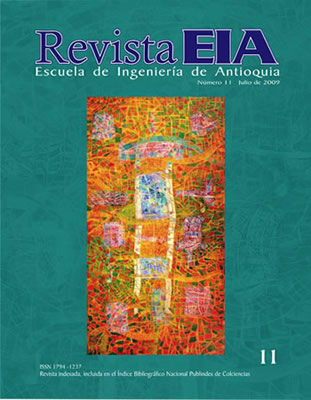DISIPADORES HISTERÉTICOS METÁLICOS COMO TÉCNICA DE CONTROL DE RESPUESTA SÍSMICA EN EDIFICACIONES COLOMBIANAS (METALLIC HYSTERETIC DAMPERS AS A SEISMIC RESPONSE CONTROL TECHNIQUE IN COLOMBIAN BUILDINGS)
DISIPADORES HISTERÉTICOS METÁLICOS COMO TÉCNICA DE CONTROL DE RESPUESTA SÍSMICA EN EDIFICACIONES COLOMBIANAS (METALLIC HYSTERETIC DAMPERS AS A SEISMIC RESPONSE CONTROL TECHNIQUE IN COLOMBIAN BUILDINGS)


This work is licensed under a Creative Commons Attribution-NonCommercial-NoDerivatives 4.0 International License.
Copyright statement
The authors exclusively assign to the Universidad EIA, with the power to assign to third parties, all the exploitation rights that derive from the works that are accepted for publication in the Revista EIA, as well as in any product derived from it and, in in particular, those of reproduction, distribution, public communication (including interactive making available) and transformation (including adaptation, modification and, where appropriate, translation), for all types of exploitation (by way of example and not limitation : in paper, electronic, online, computer or audiovisual format, as well as in any other format, even for promotional or advertising purposes and / or for the production of derivative products), for a worldwide territorial scope and for the entire duration of the rights provided for in the current published text of the Intellectual Property Law. This assignment will be made by the authors without the right to any type of remuneration or compensation.
Consequently, the author may not publish or disseminate the works that are selected for publication in the Revista EIA, neither totally nor partially, nor authorize their publication to third parties, without the prior express authorization, requested and granted in writing, from the Univeridad EIA.
Show authors biography
En este artículo se presenta un análisis cualitativo de la posibilidad de implementar técnicas de control de respuesta sísmica en edificaciones en Colombia. Teniendo en cuenta las condiciones locales actuales de la ingeniería y de las prácticas de construcción en el país, se presentan las principales razones por las que se considera que la técnica de protección pasiva de estructuras sería la más apta para ser implementada en Colombia. Se plantean aspectos deseables para la fabricación y aplicación de disipadores de energía metálicos, y se presentan los disipadores tipo riostras metálicas con pandeo restringido como una opción viable para la protección y control del daño estructural en edificaciones en el país.
Abstract: This paper presents a qualitative analysis of the possibility of implementing seismic response control techniques in buildings in Colombia. Given the current local conditions in engineering and construction in the country, herein are presented the main reasons why it is considered that the passive control of structures would be the most suitable technique to be implemented in Colombia. Desirable features on the fabrication and application of metallic energy dissipators are exposed, and metallic buckling-restrained braces (BRB) dissipators are presented as one viable option for the protection and control for structural damage of buildings in the country.
Article visits 1480 | PDF visits 739
